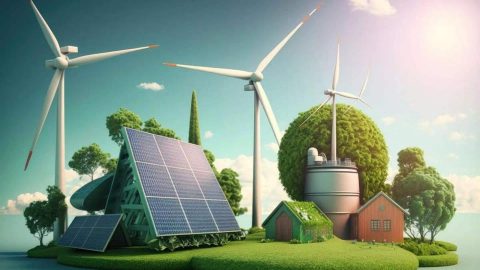Introduction
That monthly electricity bill? It’s only showing you half the story. What it doesn’t tell you is how much energy was wasted just to keep your lights on—literally thrown away as heat in the air. In a world where every unit of energy counts, that’s a luxury we can’t afford anymore.
Table of Contents
This is where combined heat and power (CHP) flips the script. Instead of wasting excess heat, it captures and reuses it—turning what was once lost into something powerful. In this blog, we’re breaking down exactly how CHP works, why it’s being adopted by hospitals, factories, and universities, and how it could transform your own approach to energy efficiency.
Combined Heat and Power: The Future of Smarter Energy Use
What is combined heat and power (CHP)?
Combined Heat and Power (CHP), another name for cogeneration, is an intelligent system of energy that does two things: it generates electricity and harvests the heat that comes along with it—instead of wasting it. This trapped heat can then be applied to heat buildings, generate hot water, and generate power for an industrial process.
The reason why CHP is unique is the efficiency factor. A common power plant wastes a tremendous amount of energy (sometimes up to 60%) as wasted heat. By putting that heat to use, however, a CHP system can attain total efficiency rates of 60%-80% when compared to less than 45% of most conventional systems. That’s a major win on both saving energy costs and emitting less.
What Are the Working Principles of a CHP System?
A combined heat and power system is at heart an energy multitasker. Instead of generating electricity somewhere and heat elsewhere, CHP accommodates both of these processes in a single, efficiently compacted configuration—minimizing energy loss and enhancing total efficiency.
Here’s a simple breakdown:
- Fuel In, Power Out: A CHP system typically begins with a fuel such as gas, biomass, or even biogas. This fuel drives a prime mover, for example, a gas turbine or engine, to produce electricity on-site.
- Capturing the Heat: As electricity is generated, plenty of heat is produced naturally (just the same way with an engine). However, unlike old power plants, which simply release that amount of heat, CHP systems capture and reuse it.
- Using the Heat: That heat which was recovered can then be utilized immediately to heat buildings, to produce hot water, drive industrial processes, or even absorption cooling systems in the summer.
Benefits of CHP Systems: What Makes Them Efficient
Combined Heat and Power (CHP) systems represent a groundbreaking approach to energy generation, offering substantial benefits that go beyond traditional methods. By simultaneously producing electricity and thermal energy from a single fuel source, CHP systems maximize energy use, reduce waste, and provide both economic and environmental advantages. Let’s break down how they offer these benefits and why they are so efficient.
- Lower Energy Bills
Since the CHP systems produce both power and heat at the site, businesses can reduce the energy bought from utilities. This two way use of fuel translates to huge money savings in the long run particularly in areas with a high energy demand.
- Higher Efficiency
Traditional methods of generating power waste so much energy in the form of heat. Rather than allowing extra heat to be wasted, CHP systems collect and reuse it. This smart use of fuel means less wastage and more output for the same amount of energy—a winning proposition economically and environmentally.
- Reliable Power Supply
CHP units may function off the grid, and that means minimal disturbances when there is an outage. Such increased reliability is especially relevant for those operations which can’t afford downtime, such as data centers or research labs.
- Customizable and Scalable
CHP systems aren’t one-size-fits-all. They can be designed according to the small commercial setups or big industrial plants based on their needs of energy. Because of this flexibility, smaller organizations can also conveniently transition to efficient energy systems.
- Smaller Carbon Footprint
CHP systems also emit less CO₂ because they use the energy with more efficiency. The adoption of CHP on a large scale can cut global CO₂ emissions by as much as 250 million tonnes per annum, according to a recent study by IEA Bioenergy. For businesses trying to achieve sustainability targets, this is a big leap.
- Government Support
In most areas, having a CHP system will give you access to grants, tax credits, or low-cost loans. For instance, the UK Department for Business, Energy & Industrial Strategy (BEIS) stated that businesses that invest in CHP technologies enjoy incentives to reduce the cost of installation and speed up return on investment (ROI). Such financial support can substantially cut the initial costs, and the option of adopting CHP becomes even more appealing to the enterprises that are looking for a greener energy solution.
In other words, CHP systems provide a viable means for cutting down costs, improving the consumption of energy, and minimizing the effects on the environment—all of that while enhancing energy independence. That is why more and more businesses are making a switch.
Conclusion: One System, Multiple Gains
By collecting and using what others waste, combined heat and power (CHP) fulfills the pledge of smarter, cleaner energy. It reverses the norm for power production—wasted excess heat—into making every ounce of fuel count for something useful. For any company that prioritizes sustainability and efficiency in its work, CHP is not something to choose but something to implement, as it’s a long-term strategy towards success.
So is your business ready to embrace the future of energy efficiency? Share your thoughts on how CHP could transform your operations in the comments below—we’re excited to hear your perspective and ideas!






